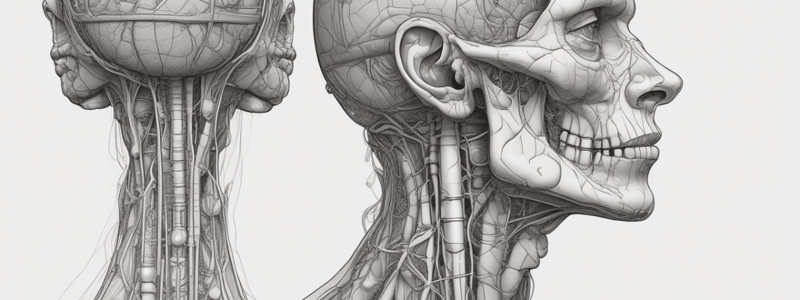Podcast
Questions and Answers
The vault is the lowest part of the cranium, the base of the skull is the upper part of the cranium.
The vault is the lowest part of the cranium, the base of the skull is the upper part of the cranium.
False (B)
The maxilla has a supraorbital notch or foramen.
The maxilla has a supraorbital notch or foramen.
False (B)
The coronoid process of the mandible articulates with the temporal bone in the temporomandibular joint.
The coronoid process of the mandible articulates with the temporal bone in the temporomandibular joint.
False (B)
The zygomatic bone has 2 parts only, the frontal process and the temporal process.
The zygomatic bone has 2 parts only, the frontal process and the temporal process.
The internal acoustic meatus is observed on the lateral side of the petrous part of the temporal bone.
The internal acoustic meatus is observed on the lateral side of the petrous part of the temporal bone.
The anatomical position describes a person standing erect, with the upper limbs by the sides and the face and palms of the hands directed backward.
The anatomical position describes a person standing erect, with the upper limbs by the sides and the face and palms of the hands directed backward.
The term ipsilateral refers to the same side of the body, while contralateral refers to opposite sides of the body.
The term ipsilateral refers to the same side of the body, while contralateral refers to opposite sides of the body.
Abduction is a movement of a limb toward the midline of the body in the coronal plane, while adduction is a movement of a limb away from the midline in the coronal plane.
Abduction is a movement of a limb toward the midline of the body in the coronal plane, while adduction is a movement of a limb away from the midline in the coronal plane.
Protraction involves moving a body part forward, while retraction involves moving it backward.
Protraction involves moving a body part forward, while retraction involves moving it backward.
The dermis is composed of dense connective tissue containing many blood vessels, lymphatic vessels, and nerves.
The dermis is composed of dense connective tissue containing many blood vessels, lymphatic vessels, and nerves.
A skeletal muscle has two or more attachments. The attachment that moves the most is referred to as the origin, and the one that moves the least is the insertion.
A skeletal muscle has two or more attachments. The attachment that moves the most is referred to as the origin, and the one that moves the least is the insertion.
The Prime mover is a group of muscles responsible for a particular movement.
The Prime mover is a group of muscles responsible for a particular movement.
Bone exists in two forms: compact (cortical) bone that contains a network of trabeculae, and cancellous (spongy) bone that contains a solid mass.
Bone exists in two forms: compact (cortical) bone that contains a network of trabeculae, and cancellous (spongy) bone that contains a solid mass.
Flashcards are hidden until you start studying
Study Notes
Anatomical Position and Movement
- The anatomical position is a description of the human body standing erect, with the upper limbs by the sides and the face and palms of the hands directed forward.
- Ipsilateral refers to the same side of the body, while contralateral refers to opposite sides of the body.
- Abduction is a movement of a limb away from the midline of the body in the coronal plane, while adduction is a movement of a limb toward the body in the coronal plane.
Protraction and Retraction
- Protraction is to move forward, while retraction is to move backward.
Skin and Muscles
- The dermis is composed of dense connective tissue containing many blood vessels, lymphatic vessels, and nerves.
- A skeletal muscle has two or more attachments, with the attachment that moves the least referred to as the origin and the one that moves the most referred to as the insertion.
- The prime mover is a group of muscles responsible for a particular movement.
- Smooth muscle can be found in the tubes of the body, walls of the blood vessels, and the digestive system.
Bone Structure
- Long bones have a tubular shaft, the diaphysis, with a central marrow cavity containing bone marrow, and an epiphysis at each end.
- Bone exists in two forms: compact (cortical) and cancellous (spongy), with compact bone containing a network of trabeculae and cancellous bone containing a solid mass.
Skull Anatomy
- The vault is the highest part of the cranium, and the base of the skull is the lower part of the cranium.
- The maxilla does not have a supraorbital notch or foramen.
- The coronoid process of the mandible does not articulate with the temporal bone in the temporomandibular joint.
- The lesser palatine foramina are located in the pyramidal process of the palatine bone.
- The occipital bone articulates with the atlas.
- The orbital portion of the frontal bone forms the roof of the orbit and the floor of the anterior cranial fossa.
- The perpendicular plate descends from the cribriform plate of the ethmoid to form part of the nasal septum.
- The zygomatic bone has 3 parts: the frontal process, temporal process, and maxillary process.
- The optic canal is found in the body of the sphenoid.
- The internal acoustic meatus is observed on the posterior surface of the petrous part of the temporal bone.
Studying That Suits You
Use AI to generate personalized quizzes and flashcards to suit your learning preferences.




